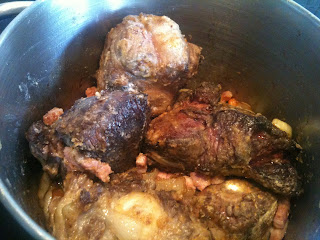This isn't terribly innovative I suppose - its just something I wanted to try out and an adaption of something an ex-boyfriend used to make as his cooking-to-impress-people dinner - and it worked! It was delicious and simple - create a pocket in a chicken breast, stuff it with cream cheese and herbs, wrap it in foil and bung it in the oven - et voila - guests impressed and pats on the back all around. I've rather destroyed the simple bit with this recipe, but I had time on my hands on a Sunday and a very clear idea in my head of what I want to achieve.
The end result should be a tasty mix of flavours, textures and colours - from the meaty cut of chicken, a crispy Serrano shell, a creamy and crunchy interior and a lovely fragrance from the thyme. I went off piste and this time it turned out pretty well!
Ingredients:
Serves 2 or 3 depending on how hungry/greedy you are
- 4 chicken thighs
- 1 tub of garlic and herb cream cheese
- 6 fresh asparagus spears
- 4 slices Serrano ham (or other similar finely sliced proschiutto)
- bunch of fresh thyme
I served it with parpadelle with green vegetables and thyme but you could serve it with new potatoes and green veg - whatever you fancy really.
- Remove the skin and bone from the chicken thighs so that you end up with one piece of meat - of there is a very thick bit then butterfly it out a bit. I'm not going to attempt to describe how to do this - this vid is a pretty good demonstration:
- Wash the asparagus and snap and discard the thick part of the stalk. Cut the asparagus in to pieces that are approx the same length as your chicken thigh bones. Place in a container with a lid, cover in boiling water, replace the lid and leave for 2 minutes. Drain and plunge into ice water to cool. This part cooks the asparagus and helps it maintain its bright colour.
- Drain the asparagus and leave to dry. Strip the thyme leaves from the stalks and discard the stalks.
- Lay one slice of Serrano ham on its packing cellophane, some greaseproof paper or some cling film. Sprinkle with some of the thyme leaves
- Lay one of the thighs length way along the ham. Spread a heaped dessert spoon of cream cheese over the central third, add a few more thyme leaves and lay three pieces of asparagus across the centre of the thigh.

- Now its rolling time. Take hold of one end of the cellophane and use it fold over the edge of the ham and chicken. Using the plastic, roll the chicken up like a swiss roll so that you have the asparagus in the centre - keep it as tight as you can. Repeat this for all four thighs.
- Wrap you little meaty parcel tightly in cling film and chill in the fridge for a couple of hours. This helps the roll to set in to its new shape and for the chicken to take on more flavour from the thyme, cream cheese and Serrano ham. It also means that you can easily do this fiddly bit in advance.
- When you're ready to cook, pre heat the oven to C180 for a fan oven, slightly hotter for a conventional oven. You now need to change your wrapping - remove the cling film and wrap in foil. I found that putting them in the centre of a square of foil and then folding the sides in so that the overlap was at the top worked the best. I tried rolling it and twisting the ends like a Christmas cracker but there was definitely more leakage this way.
- Place on a baking sheet in the oven for about 25 minutes. While they are cooking, prepare your pasta or what ever you've decided to serve it with.
- After 25 minutes remove from the oven, open the little parcels and carefully pour the liquor into a bowl or jug. If you are making the parpadelle recipe then pour the liquor into the pasta sauce.
- Leave the chicken sat in their parcel but pull back the foil. Pop them back in the oven for 5 minutes to crisp the outside slightly.
- Remove and put all four pieces on to a board or warmed plate to rest for a moment. Again collect any of the juices from the parcels or that appear while the meat rests.
- Either serve your rolled, stuffed chicken thighs whole or slice them into 4 or 5 pieces each, and lay out prettily on top of your pasta or beside your chosen accompaniments if you are feeling fancy. If not using the reserved cooking liquor in the pasta sauce, then keep it warm and serve as a jus with your finished dish.
- Devour with alacrity and marvel at your skill!

















































